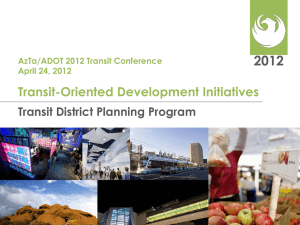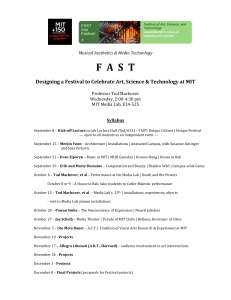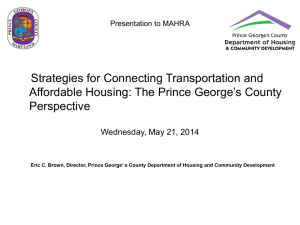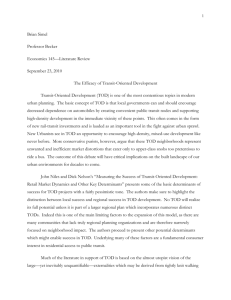Whitepaper on Transit Oriented Development
advertisement
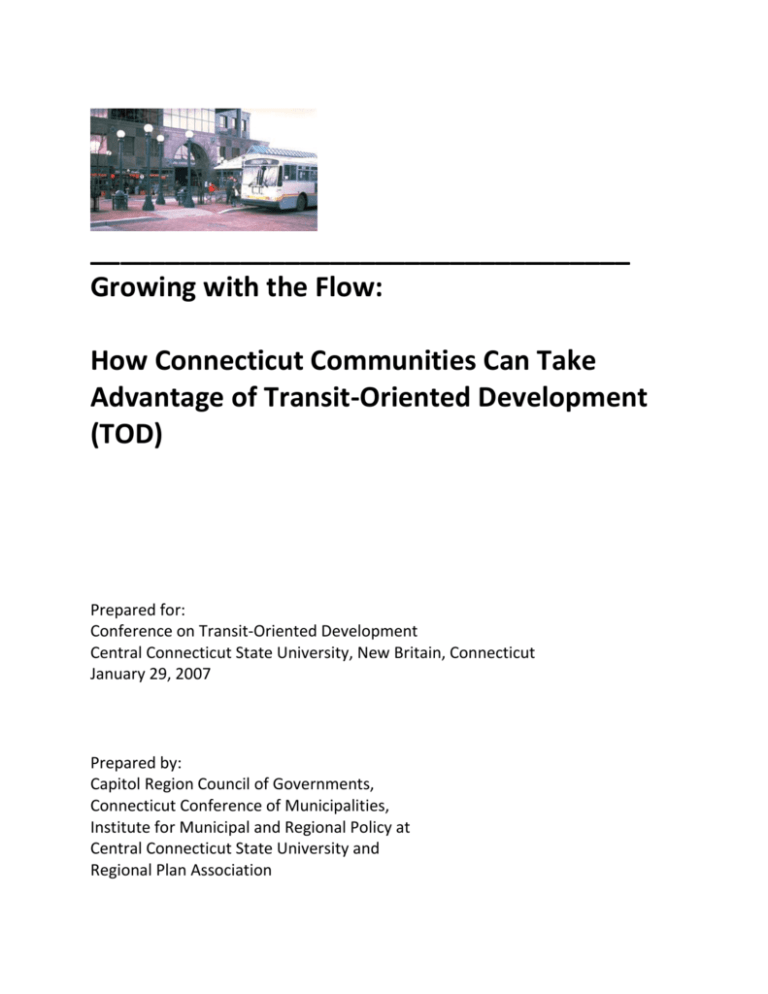
____________________________________ Growing with the Flow: How Connecticut Communities Can Take Advantage of Transit-Oriented Development (TOD) Prepared for: Conference on Transit-Oriented Development Central Connecticut State University, New Britain, Connecticut January 29, 2007 Prepared by: Capitol Region Council of Governments, Connecticut Conference of Municipalities, Institute for Municipal and Regional Policy at Central Connecticut State University and Regional Plan Association 2 __________________________________ Growing with the Flow: Table of Contents Executive Summary ……………………………………………………………………….…5 1. Introduction………………………………………………………………………………....9 2. What Is TOD and What Are Its Potential Benefits?....................…………………..10 3. Case studies: Where Has TOD Been Successful?…...............……………………..14 4. What Are Some Challenges To Doing TOD In CT?...........................…......….…..20 5. What Support Is There For CT Municipalities To Do TOD?.............…....…….……24 6. Conclusion: What’s In It For CT and How Can We Take Full Advantage Of TOD?..………………………………………………………………………….……………….29 3 4 __________________________________ Growing with the Flow: Executive Summary Connecticut can use its increased funding for an expanded rail and bus transit network to revitalize old neighborhoods and create compact and walkable, mixed-use villages (TransitOriented Development (TOD)) around bus and rail stops. Both challenged and desirable neighborhoods can capture the added economic stimulus of transit services to become more viable. Changing demographics, consumer preferences, and business strategies are bolstering the market for TOD and its potential beneficial impacts. It worked in San Francisco, Washington DC, Portland, Oregon, and Curitiba, Brazil; it can work in Connecticut. Successful TOD requires a dedicated, long-term, vision oriented, public and private collaboration to create the design and to achieve a mixture of uses with a focus on pedestrian and transit travel. Planning and zoning regulations need to be revised to allow for increased density and to resolve conflicts between local development goals and the demands for outsider access, such as park-and-ride lots. The rewards of successful TODs are increased property tax revenues, more customers for retail businesses, greater access to the regional workforce, and a more viable, regional transit system. TOD can be an alternative to a half-century of development dominated by piecemeal suburban residential subdivisions and commercial growth along increasingly congested roadways. The opportunity to reinvigorate older, automobile-oriented 5 neighborhoods, to provide an alternative to sprawl and to create a more extensive, viable and energy efficient transit network are objectives worth pursuing. A variety of housing sizes, types, and ownership structures is a key to attracting individuals and families to TOD’s walkable streetscapes that foster interaction and excitement. The impacts of neighborhood revitalization can spill beyond the ¼ to ½ mile “walking circle” of the TOD. While not a panacea for all people or all transportation ills, TOD does represent a viable choice for many communities. While much praised, there are few agreed upon methods for creating TODs and measuring their impact. Case studies reviewed here (Georgetown in Redding, CT, MetroCenter, in Fairfield CT, Warwick Station in Rhode Island, “transit villages” in New Jersey, and the busway investments in Pittsburgh, Pennsylvania) illustrate some common themes: Strong, long-term leadership, Vision to keep market and regulatory forces focused on the objective, Collaboration among many players in complex negotiations, Assembly of diverse private and public funds from multiple institutions and organizations, Overcoming neighborhood resistance to change and to new forms of development at higher densities, Withstanding the long learning curve of developers, land appraisers, mortgage lenders, town planners, and planning and zoning commissioners who are most comfortable with the familiar pattern of single purpose, low-density development on undeveloped land. Supportive policies and financial resources for Transit-Oriented Development are increasing. The 2005 State Plan of Conservation and Development set six new growth principles, many of which are directly or indirectly implemented through TOD. Local plans must adhere to the new growth principles and where feasible must identify compact, transit accessible, pedestrian-oriented, mixed-use development and land reuse patterns. 6 Governor Rell’s Executive Order No. 15 directed, among several other things, that Regional Roundtables with municipal officials’ participation develop planning agendas for new transit corridors. It also called for a review of state policies and funding programs in order to promote mass transit and target funds to “responsible growth” areas. Recent changes to federal transportation funding programs have enhanced opportunities for TOD. A serious land use component has become more critical to project evaluation and funding decisions. The Federal Transportation Administration has greater flexibility to work with the private sector and others to promote Transit-Oriented Development. The Transportation and Community and System Preservation program continues to provide grants to “investigate the relationships between transportation, community, and system preservation plans.” Connecticut legislation in 2005 and 2006 provided a total of $3.6 billion for transportation improvements with the majority of the funds earmarked for transit projects including the New Haven-Hartford-Springfield rail line and the New Britain to Hartford Busway among other projects. Connecticut Public Act 06-136 authorized bond, loan, and grant funding for TOD and centralized the responsibility for coordinating economic development, housing, and transportation with the Secretary of the Office of Policy and Management. TOD helps to create a vibrant urban social and economic vitality, to connect workers to jobs and take vehicles off the roads, to encourage infill and redevelopment, to lessen development pressures on open space and to connect the State to the national and global economy. Now is the time for Connecticut to take advantage of emerging opportunities for Transit-Oriented Development. 7 _____________________________________ Growing with the Flow: 1. Introduction The State of Connecticut is on the cusp of a new round of infrastructure investments in rail and bus transportation. There is evidence that shifts in demographics, consumer preferences, and business strategies are providing a market for development that can leverage these investments and have a beneficial impact on many Connecticut communities. Over the past half-century, jobs, retail establishments, and residences have increasingly located in the suburbs resulting in longer car trips to accomplish the same tasks that once took place in more compact urban areas. This has caused more traffic congestion that negatively affects economic growth and the quality of life in Connecticut. Transit-Oriented Development is an opportunity to reinvigorate older, automobile-oriented neighborhoods and provide an alternative to continued suburban sprawl while capitalizing on Connecticut’s proposed transportation investments. 8 ____________________________________ Growing With The Flow: 2. What Is TOD and What Are Its Potential Benefits? Transit-Oriented Development (TOD) refers to development around a public transit stop that is walkable and compact with a mix of building and space uses. In TOD, land uses and street patterns support walking to and from bus and rail stops with easy access to jobs, housing, services and products. TOD gives towns and cities the tools to generate and capture economic benefits from train, light rail, rapid-transit bus stations and bus corridors. In fact, from Portland, Oregon, to Curitiba, Brazil, to Redding, Connecticut, towns and cities are working to reap the benefits of TOD. TOD is not just for large urban areas. TOD design and planning techniques have been applied successfully all over the world on all scales. The basic principles -- a mixture of uses and a focus on pedestrians -- are relevant to any Connecticut town with rail service or other forms of public transit. For example, when Arlington County, Maryland began planning for a new metro line to Washington, DC, plans and zoning regulations were revised to increase density and to create mixed-use, walkable, village development around each transit station. This helped to conserve the low-density areas considered so important to their local heritage and quality of life. Many of Connecticut’s small towns share the same concerns and could benefit from TOD planning principles. 9 Supportive land use promotes transit ridership. Supportive land use is critically important to high-quality mass transit. All transit routes, including local bus routes, need a threshold level of development before service can be justified. While park-and-ride lots can meet that need, TOD can offer additional benefits. A variety of land uses around transit stops and along transportation corridors can provide opportunities for work, shopping, medical visits, and recreation, among others. This activity level along the entire transit corridor strengthens transit service and creates a nucleus for community development at each transit stop. TOD requires partnerships. A successful TOD requires the long-term collaboration of many partners, including transit agencies, local jurisdictions, funding groups, property holders, developers, tenants, surrounding towns and cities as well as state and federal agencies. The complexity and difficulty of creating and sustaining a successful partnership from the planning phase to project completion and operation cannot be underestimated. However, there are many rewards for those that do. Municipalities reap the rewards of creating a lively, public place that generates more property tax revenues. Businesses improve access to clients and the local and regional workforce. Neighborhood retailers increase their customer base with new transit users, TOD residents, and other pedestrians. Regional partners benefit from an attractive new development and transportation center that can strengthen the regions’ appeal and increase property values. The change in behavior is daunting and large and the expenditure could be significant, but the costs of continued inaction may be higher still. Housing is a key element. The inclusion of a variety of housing options is a key component of a successful TOD strategy. Housing should be available in the sizes, types, and ownership structures that appeal to a wide range of demographics — from young couples to 10 retiring baby boomers. A set-aside percentage of affordable housing within TOD can provide the vibrancy created through socio-economic diversification, and expand the potential funding and financing options for those pursuing a TOD project. Communities can use this opportunity to diversify their real estate market. In order to maximize developer interest and most efficiently use a community’s land and transportation infrastructure, housing should be included in TOD projects. Focus on pedestrians. The TOD focus on pedestrians helps counter many of the negative effects of auto-centered development. TOD principles emphasize more walking routes and public spaces amenable to pedestrians. Studies show there are many benefits to this approach, such as: reduced automobile trips, improved public health, increased opportunity for interaction between fellow citizens of differing backgrounds, and increased regard of residents and neighbors toward their town. The walkable streetscape favored by TOD reintroduces a way of life that consumer and residential market surveys consistently show as underserved by current economic development. These surveys indicate a preference by both retailers and residents for the interaction and excitement these mixed-use centers provide to a community. Studies show the presence of daily commuters at a rail or bus station has benefited areas beyond the ¼ to ½ mile “walking circle” (generally acknowledged as the distance pedestrians are willing to walk to a transit hub). TOD improves quality of life—a business concern. Mixed-use, Transit-Oriented Development is not a panacea for all of society’s transportation ills, but it does provide a viable alternative to long, highway commutes and can be a valued choice for residents. For those who 11 choose the option, long commutes are replaced with a little more fresh air, a little more exercise, and a little more civic and interpersonal interaction. A TOD situated on a convenient transit system can also reduce personal transportation costs. Businesses across the country have taken notice. Quality of life for its workers is an important determinant of where they will choose to locate offices and their investment dollars. 12 ____________________________________ Growing With The Flow: 3. Case Studies—Where Has TOD Been Successful? Connecticut—Georgetown TOD. The Georgetown TOD in the Town of Redding is in the process of taking a blighted and contaminated brownfield site and turning it into a village center with 416 units of varied housing and 300,000 square feet of commercial space next to a newly reopened railroad station on the Norwalk to Danbury branch of the New Haven railroad line into Manhattan. The 55-acre site of the former Gilbert and Bennett wire mill provided the Town of Redding and the Georgetown Land Development Company with the opportunity for redevelopment near an existing transit line. This project has required many key players to work together. For example, the Connecticut Business and Industry Association (CBIA) brought 100 state legislators and officials from the CT Department of Economic and Community Development (DECD) and CT Department of Environmental Protection (DEP) to the site for their Environmental Policies Council meeting. The legislature created the Georgetown Special Taxing District, encompassing the mill site, and enabled the District to issue bonds secured by District taxes and fees. Many funding sources at both the federal and state level are available to help with needed brownfield remediation. Redding received a federal Small Cities grant in February 2006 for $600,000 to begin the necessary site remediation. In 2006, the U.S. Department of the 13 Treasury designated the Georgetown Special Taxing District as a qualified green building and sustainable design project, which made the District eligible to issue $72 million in tax-exempt, private activity bonds. Another $5 million was received from the United States Department of Agriculture to finance the development of the wastewater treatment facility. A local bank is making construction financing available. In 2005, the Georgetown project was selected from 98 projects as the winner of the National Award for Smart Growth Achievement. The Georgetown development will add an estimated $5 million to the town tax base, and create 1,500 new jobs. Connecticut—Fairfield MetroCenter. A similar collaborative effort on the part of the town, state and federal government contributed to the creation of the MetroCenter, in Fairfield, CT. Although the MetroCenter project does not include housing, it does have 1,000,000 square feet of commercial and retail space next to a new passenger rail station. A $4 million federal grant, $6 million in state general obligation bonds and the anticipated revenue from parking fees at the station will allow the town to turn a 35-acre brownfield site into a vibrant transit-oriented commercial center. Any office tenant who chooses to locate at the Fairfield MetroCenter is eligible for the Industrial Site Investment Tax Credit Program administered by CT Department of Economic and Community Development. Under this program if a tenant relocates to the Fairfield MetroCenter from out of State with 200 employees, for example, and an econometric study calculates that these 200 employees will generate $10 million in Connecticut tax revenues over a ten-year period either directly, as through wage taxes, or indirectly, as through their purchases in Connecticut, the tenant would receive a $10 million tax credit that it can use towards paying its Connecticut corporate taxes. 14 Fairfield MetroCenter promises not only to benefit Fairfield, but as reported in the New York Times, may have many positive economic effects on Bridgeport’s nearby Black Rock neighborhood. Rhode Island—Warwick Station. The Warwick Station Project in Rhode Island includes the construction of a combined passenger train station and rental car facility at T.F. Green Airport, in Warwick, Rhode Island. The $160 million undertaking, led by the state transportation department and T.F. Green Airport Corporation, is supported by revenue bonds, and federal and state funds. The facility will be linked to the airport by a 1,500-foot elevated automated people mover. Developers have committed $10 million to acquire nearby land. A 200-room hotel is anticipated to abut the new intermodal facility. Additional investment in office and retail space in a pedestrian-friendly transit village is anticipated. New Jersey Transit Villages. A number of municipalities in New Jersey have been extremely successful in collaborating and developing financing mechanisms to initiate TODs. New Jersey municipalities that have accomplished TOD have found the benefits to be significant in terms of tax base, transit ridership, incorporation of affordable housing and overall sense of community and vitality. Presently, New Jersey has seventeen named Transit Villages. Many New Jersey municipalities are comparable in population size and land area to Connecticut municipalities. New Jersey—Township of South Orange. South Orange has 17,000 residents and has had train service to Manhattan for many years. NJ Transit owns the historic South Orange train station. The TOD effort arose from the desire of NJ Transit to provide more parking to meet the demand for new service and to renovate blighted stores on NJ Transit property. A 15 redevelopment plan called for a village center. The Township entered into a partnership with a local real estate development firm. NJ Transit invested in new rolling stock and bought out the lease for the retail space in the train station. The private firm secured tenants for the retail spaces. The National Main Street Program assisted in the phased program that began with small-scale public improvements such as storefront, streetscape and traffic-flow to enhance the pedestrian environment. The Township and NJ Transit negotiated a shared parking agreement that brings longterm commuter parking within 1,200 feet of the station. Parking serves both the station and the retail shops in the village center. Funding sources included Community Development Block Grants from the U.S. Department of Housing and Urban Affairs, low-interest loans from the Essex County Improvement Authority, private donations and municipal and county bonds. Early on, tax incentives were offered to launch the residential market, but these incentives are no longer necessary. Impacts of the TOD have been encouraging. The project has increased the village center’s assessed tax base from $838,000 to nearly $4 million and boosted the overall township’s tax collection by $100,000 per year. As retail leases have turned over, rents have almost doubled. NJ Transit ridership at the South Orange station has increased 150% from 1995 to 2000. Correspondingly, single-occupant auto trips have decreased from 63% to 54% for the Township between 1990 and 2000. New Jersey—Township of South Orange, Gaslight Commons. Gaslight Commons is a 200 unit TOD built on the site of a former auto dealership. The Gaslight Commons developer 16 created a partnership with South Orange to expedite the development process. While tax abatements were used to spur initial residential development, the neighborhood became marketable and tax abatements became unnecessary. The TOD has increased the South Orange tax base by $500,000 per year. Bus Rapid Transit. The potential impacts of Bus Rapid Transit (BRT) on commercial property in Canada, Australia and Latin America suggest that BRT investments can have substantial market impacts. The number of BRT systems in the United States is modest compared to heavy rail, commuter rail and light rail systems, but recent surveys have shown that significant mixed-use development is occurring. Pittsburgh, Pennsylvania Busway Investments. The Port Authority of Allegheny County, PA reports development valued at $300 million along the Martin Luther King, Jr. East Busway between 1983, when this facility opened for service, and 1996, when the inventory was conducted. They have not conducted a full inventory since 1996, but estimate another $203 million worth of development has occurred between 1996 and 2004 and more development has recently been completed, is under construction, or is being proposed. Furthermore, the Authority website states that the "Port Authority continually looks for opportunities to partner with local and state development agencies on ways to maximize development and public transportation.” To that end, the Authority has prepared the 20/20 Vision, which "proposes creative land use and development strategies and a mixture of rapid transit, fixed-route bus services and other public transit services and amenities that could enhance smart growth and connect people to recreation, economic and employment centers within the nine-county region." 17 18 __________________________________ Growing With The Flow: 4. What Are Some Challenges To Doing TOD In CT? While TOD is gaining popularity, it has also encountered obstacles. Since TOD requires collaboration on the part of many players, it can be difficult to engage all of the key people in a municipality or project. Many fear that TOD projects will incur higher costs and risks and that there is no existing market for TOD. In addition, land use regulations that are primarily designed to control suburban subdivision development can inhibit mixed-use, pedestrianoriented TOD. The status quo. A major obstacle to TOD is the familiarity and comfort of developers, land appraisers, mortgage lenders, town planners, planning and zoning commissioners, and others with the current pattern of low-density development on open land. Low-density development is viewed as a safe way to make a profit, address market demand and increase the local tax base. TOD is not always seen as a market acceptable, tax-generating development. Fear of density. Fear of density persists despite acknowledgement of the negative effects of sprawling development. Decision-makers and citizens often balk at the idea of increased densities because of perceived negative impacts on the community. Yet research on the topic finds no correlation between density and a vast array of problems. The research shows that 19 density results in many benefits to neighborhoods and regions and is desired by a significant portion of the population. Former Governor of Maryland, Parris Glendenning, now a national leader in “Smart Growth” development, often refers to studies that assert that one-third of the population in the U.S. would prefer to live in denser, village-style neighborhoods. Furthermore, when given the choice between spending the day in a suburban strip-mall development or a vibrant, mixeduse, walkable village center with shopping and restaurants, most suburban dwellers would choose the latter. Research shows that dependence on the automobile begins to decline and the use of walk/bike/transit modes increases at housing densities of 12 dwelling units per acre (the equivalent standard for the density of jobs needed to promote the use of walk/bike/transit modes is 25-50 jobs per acre.) At 16 units per acre, these trends become significant. This standard can easily be met with townhouse-style developments or a mixture of small-lot, single-family homes combined with some 3- to 4-story multi-family structures. A number of successful neighborhoods around the West Hartford, Connecticut center are good examples. Other findings include: Residential density does not increase traffic congestion. Per capita energy usage is lower in denser areas as a result of the reduction in vehicle trips and trip length. Density is not associated with increased crime rates. Density can lead to increases in disposable income by reducing average household transportation costs. 20 Public infrastructure capital and operating expenditures are lower in densely populated areas. Both commercial and residential properties in close proximity to transit stations enjoy a property value premium. Increased property values around transit stations translate into increased property tax revenues for municipalities. A more extensive discussion of density can be found in a Capitol Region Council of Governments (CRCOG) publication entitled New Britain-Hartford Station Area Planning Project Parkville Station Area on their website (www.crcog.org). Increasing numbers of TOD success stories should help to allay density fears. Lack of TOD evaluation standards. While TOD has garnered praise throughout the world, there is no agreed upon method for evaluating TOD projects and their impact. New Jersey has developed common criteria for measuring the success of their TOD projects. They include: tax revenue impact per year, number of housing units developed, size of the footprint of the entire development, numbers of cars per unit, units per acre and children per unit. These criteria could be the basis for a more widely recognized TOD evaluation system that would support the anecdotal benefits of TOD. Mayor Jim Maley of Collingswood Borough, New Jersey, provides some compelling reasons to support TOD in his remarks below: Having a sea of parking does nothing for anyone, ‘There's no benefit to the town.’ ‘It [TOD] is the most logical way to go for developed towns to increase the ratable base,’ ‘It helps the trains, it helps the businesses, and helps the town overall with more vibrancy.’ Maley said the transit village: ‘doesn't have the typical singlefamily housing and doesn't bring a lot of kids. There is more housing for empty nesters, more for young folks. It also provides property-tax relief. You don't have to build new schools for this. You don't have to add more cops for this. It makes sense.’ 21 A widely accepted method of evaluating TOD would provide additional data to support these statements. 22 ____________________________________ Growing With The Flow: 5. What Support Is There For CT Municipalities To Do TOD? There are an increasing number of supportive policies and resources for TransitOriented Development. Some of them are: Federal legislation. The Safe, Accountable, Flexible, Efficient, Transportation Equity Act (SAFETEA-LU) of 2005 is the major federal source of transportation funding for the state of Connecticut until 2010. The August 2005 newsletter of the Center for Transit-Oriented Development summarized transit-related amendments in SAFETEA-LU and concluded that new transit programs and policy changes may enhance opportunities for TOD. The New Starts program, which is the means for funding major transit capital investments, was altered in several ways. One is that New Starts projects are authorized now with General Fund money, not Highway Trust Fund money. This change can be viewed positively in that increased demand for New Starts funding could result in Congressional pressure to increase overall transit funding, which could in turn create opportunities for TOD. However, it is also possible that transit may suffer if it has to compete for funding with nontransportation programs. Other language in SAFETEA-LU elevates the role of land use and economic development among the various factors to be considered by the Federal Transit Administration (FTA) as it 23 evaluates projects for New Starts funding. This means that transit projects for which Connecticut seeks New Starts funding will need to include a serious land use component early in the evaluation process and continue to make progress coordinating land use with a proposed transit project to receive New Starts funding. Early coordination between governmental entities involved in land use decisions is critical if we are to ensure general TOD opportunities are not missed and that joint development occurs at station sites. "Joint development" typically refers to development in which the transportation facility is part of a larger development that serves other purposes, e.g. residential or commercial. If planned correctly, the transit facility absorbs some of the capital costs, which, in addition to great transit access, is a ‘carrot’ for enticing development. Finally, SAFETEA-LU enacted amendments to the definition of the term "capital project,” as the term relates to joint development, which enhanced the ability of FTA grantees to work with the private sector and others for purposes of joint development. Even the requirement that development be physically part of a public transportation facility has loosened. FTA's guidance for implementing SAFETEA-LU amendments directly states that it seeks 1) to afford FTA grantees maximum flexibility to work with the private sectors and others for purposes of joint development, 2) to utilize Federal Transit funds and program income for joint development purposes, and 3) to promote Transit-Oriented Development. The Transportation and Community and System Preservation, (TCSP). The TCSP program provides grants and research to “investigate the relationships between transportation, community, and system preservation plans.” Besides money for studies, planning, and fact finding, the provision has substantial funding for brick and mortar improvements to 24 transportation efficiency and other similar efforts aimed at reducing environmental impact, reducing future public infrastructure costs, and helping ensure efficient access to jobs, services, and centers of trade. The TCSP is a congressional earmark program and funding requests must be made through Congressional representatives. Priority of grant selection is determined by the following criteria: A coordinated conservation and development plan that promotes cost-effective investment and private sector strategies exists, A TCSP policy initiative has been implemented, The plan addresses environmental mitigation, and The plan encourages private sector involvement. In Connecticut, grants were made to the Farmington Canal Greenway, Talcottville Transportation Improvement Project, Mystic streetscape work, New Haven Trolley Cars, Stamford’s Waterside Village, and nearly $2,000,000 to Derby to help alleviate traffic congestion. The Capitol Region Council of Governments received a TCSP grant that focused on local and regional growth policies and produced a neighborhood plan for Hartford’s Parkville neighborhood in preparation for the New Britain/Hartford busway, which will have a station in Parkville. CT State legislation and executive action. Legislation in 2005 and 2006 provided a total of $3.6 billion for transportation improvements, with the majority of the funds earmarked for transit projects. In 2006, at the Governor’s request and through a bi-partisan legislative effort, $2.3 billion was authorized to develop and enhance two major transit corridors, the New 25 Haven-Hartford-Springfield rail line and the New Britain to Hartford Busway, among other projects. Both projects have significant opportunities for Transit-Oriented Development and high economic benefits to the municipalities that choose to pursue them. In 2006, CT Public Act 06-136 made the OPM Secretary responsible for coordinating actions on economic development, housing, and transportation and authorized bond, loan, and grant funding for TOD. CT State Plan of Conservation and Development. The 2005 State Plan of Conservation and Development set six new growth principles that encourage the revitalization of regional centers, the expansion and enhancement of housing and the linking of transportation and land use around transportation nodes. Transit-Oriented Development satisfies all of these recommendations. The Plan stresses both the need to educate and to offer incentives to municipalities, developers, individuals and businesses, as well as the critical need to develop best practices and techniques for TOD in Connecticut. Legislation in 2005 required that local Plans also adhere to the new growth principles and that in addition, local Plans “identify areas where it is feasible and prudent to (i) to have compact, transit accessible, pedestrian-oriented mixed-use development patterns and land reuse, and (ii) to promote such development patterns. Connecticut Governor M. Jodi Rell’s Executive Order 15. In late October 2006, Governor Rell signed Executive Order 15 that called for: An Office of Responsible Growth within OPM to coordinate policy development and capital planning across a number of state agencies, 26 Regional Roundtables to invite ongoing participation of city/town officials and foster the development of planning agendas, starting with new transit corridors, A review of transportation policies and projects to increase opportunities to promote mass transit, and A review of all State Funding that has an impact on growth and development and establish criteria that will target funds for uses that are consistent with goals that emerge for responsible growth. 27 ____________________________________ Growing With The Flow: 6. Conclusion—What’s In It For CT and How Can We Take Full Advantage Of TOD? Connecticut is an integral part of a globally competitive region with premier cultural and educational institutions and leading corporations and financial institutions. To capitalize on these assets, the region and Connecticut must: connect employers to labor pools, provide accessible affordable housing, connect people to services and stores and achieve a seamless access to the outside world. Promoting Transit-Oriented Developments along existing and proposed rail and bus lines will help tackle these challenges by creating a strong system that will aid the mobility of commuters, residents and businesses. Linking land use and transportation through TOD will not only promote social and economic vitality within each municipality that pursues it, but will also connect workers to jobs, take cars off the roads, encourage infill and redevelopment, enhance economic development and protect open space. TODs will help the entire state meet the economic challenges of the 21st century global economy, while at the same time enhance and protect Connecticut’s quality of life. 28
